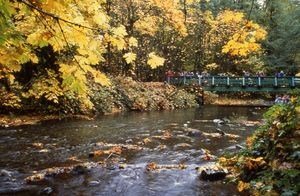
See Mother Nature at work as salmon life cycle unfolds at Victoria-area park
October 22, 2012 - 9:00 AM
LANGFORD, B.C. - A great blue heron glides overhead, effortlessly spreading its massive wings before gracefully landing on a nearby treetop high above the Goldstream River.
A bald eagle looks down at the shimmering river from its perch on a moss-covered branch of a western red cedar.
In the river, which in some parts is — maybe — 18 centimetres deep and two metres wide, salmon, 10 kilograms and larger, with their dorsal fins poking out of the water, wriggle, scoot and splash with all their might as they struggle against the current to spawning grounds upstream.
It's early fall and Mother Nature is putting on its annual West Coast salmon life cycle show just minutes from Victoria in a provincial park that offers free parking, fire pits and eyeball-to-eyeball salmon access through a series of easy-going nature trails and wood bridges.
People come by the thousands to witness the salmon spectacle, which the park bills as the Cradle and the Grave, the birthplace and burial site of the iconic species that brings life to the park's trees, animals and water.
By Christmas all the salmon are dead, their rotting carcasses covering the riverbanks. The smell is vile, putrid, rancid or whatever other name is associated with rank, but people still come by the thousands.
They come to see the eagles and other birds scavenge the bones and they might even see a bear taking one last munch of a rotting salmon before heading off for the long winter's nap called hibernation.
"The (spawning) peaks around Remembrance Day and then it starts to get really smelly after that, which is great," says Keilih Gates, one of Goldstream Provincial Park's naturalists.
She says there are naturalists on duty at the park every day of the year except Christmas Day.
The naturalists work out of the Goldstream Nature House, named after legendary park naturalist Freeman King, who helped develop the long-standing tradition of showing school children and adults the wonders of what the park calls nature's balancing act.
The returning salmon provide the entire park eco-system with ocean nutrients that amazingly can be found throughout the river's riparian zone, including evidence of salmon nutrients at the tops of 50-metre-tall cedars.
Easy-to-read park signs explain how deeply connected the returning salmon are to the park's ongoing life cycle through providing nutrients to black bears, western red-backed salamanders, western red cedars, sword ferns, pileated woodpeckers, salmonberries, bald eagles, American dippers, three-spined sticklebacks, glaucous-winged gulls, black cottonwoods, red alders, raccoons, Steller's jays and Douglas firs.
Throughout the year, the nature house is always a hub of activity as every cycle of nature is celebrated and studied, including the eagle feasts in December and January and the spring hatches of the salmon eggs.
"We've always got somebody here to tell you about the salmon and what's going on in the park," said Gates, pointing to the grassy Finlayson Arm estuary where the ocean meets the mouth of the Goldstream River, which provides freshwater access to the Pacific salmon species that spawn in the river.
Thousands of coho, chinook and chum salmon and some steelhead return to the Goldstream spawning grounds annually.
Gates says Goldstream, located about 17 kilometres north of Victoria, is home for the latest season salmon spawning run on Vancouver Island. Most salmon in British Columbia spawn in the rivers, creeks and streams of their birth throughout the summer or early fall.
An unusually dry fall this year on southern Vancouver Island kept many salmon in the ocean longer than usual, but recent rains tripped salmon instinct and they started moving up the river last week, she said.
First to come are the smaller, but spunky, coho, followed by huge chinook, some as large as 40 kilograms, followed by the chum, smaller than the chinook but larger than coho.
The chum run is the largest of the Goldstream runs and prized by local First Nations for their high oil content. There are days when First Nations take chum from the river for traditional and ceremonial purposes.
"The chum, they're hanging out in the estuary here right now, and then they'll start to come up the mouth of the river and they'll actually spawn all up the river right in front of the parking lot, which is great for viewing," said Gates.
The males turn red and their jaws become hook-shaped once they enter fresh water.
Gates says this fall's return of spawning salmon is extra special because it represents what appears to be healthy returns of salmon 18 months after a gasoline spill into the river that killed thousands of fish and threatened to pollute spawning areas.
In April 2011, a tanker truck hauling gasoline rolled on the Trans-Canada Highway near the park, leaking 42,000 litres of gasoline and 600 litres of diesel into a drainage ditch that flowed into the Goldstream River.
Gas and diesel are toxic to fish and after a $2-million cleanup effort, the park is back to health, said Gates.
"This is the first year that we would see any return of the Coho from that (April 2011) run," she said. "It looks like it's going to be a good year."
News from © The Canadian Press, 2012